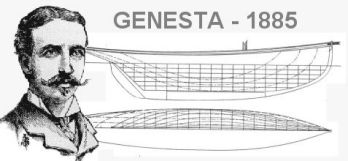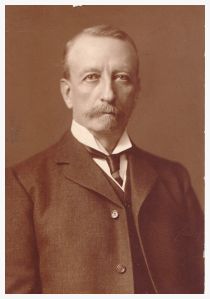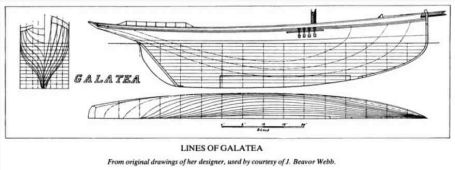Yves GARY Hits: 1200
Category: DESIGNERS
 John Beavor-Webb (1849 - March 11, 1927) was an Irish-American naval architect.
John Beavor-Webb (1849 - March 11, 1927) was an Irish-American naval architect.
He was a designer of sailing yachts, notably the America's Cup challengers Genesta (1884) and Galatea (1885), before emigrating to the United States where he designed very large steamyachts like J.P. Morgan's Corsair II (1891) and Corsair III (1899).
 John Beavor Webb (he added a hyphen to his name later) was born in August 1849 near the Old Head of Kinsale in Ireland. He attended Trinity College, Dublin, with the aim of becoming an engineer. He acquired experience with small boats very early on off the coast of Ireland, and was a highly enthusiastic yachtsman and racer. In 1867, he owned a 30 foot sloop, Truant. A year later, he bought a bigger sloop the 48-foot Eise. In 1871 he moved to the centre of British yachting, the Solent. An excellent racer, he raced his 25-foot Itchen and won 10 out of 12 races. In 1875 he worked with the modeler-builder Dan Hatchen, and had a part in the design and construction of the 5-ton yacht Freda.
John Beavor Webb (he added a hyphen to his name later) was born in August 1849 near the Old Head of Kinsale in Ireland. He attended Trinity College, Dublin, with the aim of becoming an engineer. He acquired experience with small boats very early on off the coast of Ireland, and was a highly enthusiastic yachtsman and racer. In 1867, he owned a 30 foot sloop, Truant. A year later, he bought a bigger sloop the 48-foot Eise. In 1871 he moved to the centre of British yachting, the Solent. An excellent racer, he raced his 25-foot Itchen and won 10 out of 12 races. In 1875 he worked with the modeler-builder Dan Hatchen, and had a part in the design and construction of the 5-ton yacht Freda.
He then devoted himself to yacht design and composite construction in metal and wood, and then in iron or steel. His first big order was in 1879, a 20-ton class for Sir thomas Gorston Freke, the second Freda (1880). In her first season, Freda scored 16 wins and 5 seconds out of 33 races. Two of his yachts were built in the United States: Butterfly (1883) for Edward Burgess and Medusa for F. Gordon Dexter.
In 1884, he built Genesta, a composite construction cutter for Sir Richard Sutton. He also had an order for Lieutenant William Henn, a second steel cutter Galatea. John Beavor Webb in fact issued a dual challenge with Genesta and Galatea. A good racing man, Beavor-Webb steered Genesta with Captain John Carter. His performance in the second race against Puritan was to be for a long time engraved in the memory of the yachtsmen who witnessed the race.
John Beavor-Webb took part in the first challenge in 1885 with Genesta. His time in New York completely changed his life. There he met the woman who was to become his wife and the same year decided to set up in the United States as a naval architect. But in 1886, John kept his promise. He took part in the second challenge that he had issued with Galatea, Lieutenant Henn’s steel cutter.  He was once again at the helm of the challenger, assisted by Captain Dan and a local pilot Captain Sam Gibson. Galatea was designed at the same time as Genesta and the fact that Henn’s yacht was not launched until 1885 can only be explained by a delay in construction. As a result, Beaver Webb was not able to learn from Genesta’s defeat in order to design a faster boat. Galatea ran against Mayflower who had benefitted from the experience acquired by Burgess on Puritan. It can be said that the defender was untouchable.
He was once again at the helm of the challenger, assisted by Captain Dan and a local pilot Captain Sam Gibson. Galatea was designed at the same time as Genesta and the fact that Henn’s yacht was not launched until 1885 can only be explained by a delay in construction. As a result, Beaver Webb was not able to learn from Genesta’s defeat in order to design a faster boat. Galatea ran against Mayflower who had benefitted from the experience acquired by Burgess on Puritan. It can be said that the defender was untouchable.
After the challenge, John Beavor-Webb turned towards the construction of large ships. He designed notably the second and third steam yachts for J. Pierpont Morgan Corsair and Intrepid for Lloyd Phoenix. Becoming a naval architect via an engineer’s training, having built yachts first as an amateur, with years of sailing experience, studying hull forms very early on, John Beavor-Webb was one of the new 19th century architects who were both technicians and yachtsmen. He died in 1927.

 GENESTA - 1885 |
 GALATEA - 1886 |

- John Beavor-Webb - Wikipedia, the free encyclopedia
- LOUISE GENESTA BEAVOR WEBB LEONARD, or How Did a Friend of J.P. Morgan End Up at a Goodwill Sale? - Grandma's Picture Box
